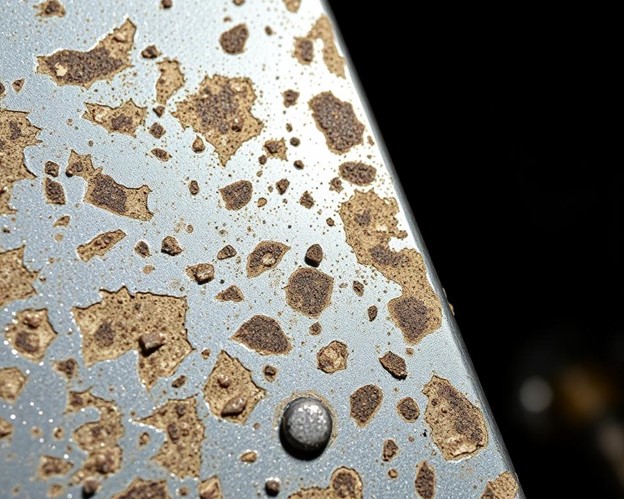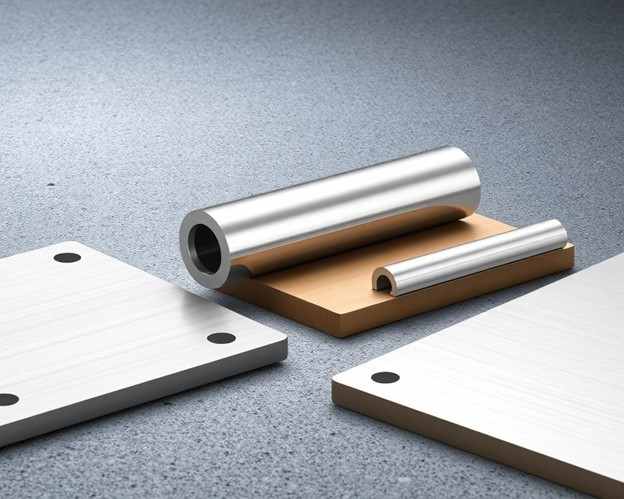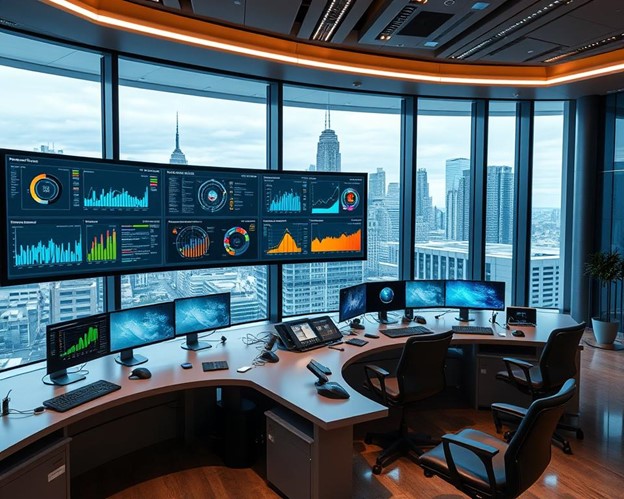DEKRA VT1000 Pitting Images: Visual Inspection Guide

Imagine looking into the hidden layers of industrial equipment. You can see signs of corrosion before they cost a lot. DEKRA VT1000 pitting images makes this possible, changing how we inspect things. But what do these images really show, and how do they protect our equipment? Find out in our detailed guide on DEKRA VT1000 and visual inspection.
Key Takeaways
Discover the power of DEKRA VT1000 Pitting Images, a revolutionary tool for visual inspection
Understand the importance of pitting corrosion and how to identify it using DEKRA VT1000 images
Explore a comprehensive gallery of pitting images, from light to severe, and learn how to interpret them
Uncover the common causes of pitting corrosion and learn effective preventive measures
Dive into the DEKRA VT1000 certification process and best practices for visual inspection
Introduction to DEKRA VT1000 Pitting Images
Exploring industrial corrosion assessment can be tough. But, the DEKRA VT1000 offers a great tool for visual checks. It’s a top-notch technology for spotting and studying pitting corrosion, a big issue for many industrial sites.
What is DEKRA VT1000?
The DEKRA VT1000 is a leading visual inspection system. It helps professionals in different fields check how bad pitting corrosion is. This tech uses high-quality images and smart analytics to give detailed views of metal surfaces. It helps find corrosion early and fix it before it gets worse.
Importance of Visual Inspection
Visual checks are key in industrial corrosion assessment. Experts look at metal surfaces to find and measure pitting corrosion. The DEKRA VT1000 makes this easier by giving clear, standard, and reliable visual analysis. This helps companies make smart choices about their assets and maintenance plans.
Using the DEKRA VT1000, companies can really understand their equipment’s state. They can focus on maintenance, plan for repairs, and make their assets last longer. This DEKRA VT1000 overview shows how vital visual checks are for safe, reliable, and efficient industrial work.
By using the DEKRA VT1000 in their corrosion checks, companies can really see the visual inspection importance. They can take a big step towards stopping the expensive and risky effects of pitting corrosion.
Understanding Pitting Corrosion
Pitting corrosion is a serious problem that can damage industrial equipment and buildings. It causes small holes to form on metal surfaces. These holes can grow and lead to equipment failure.
The main factors that cause pitting corrosion include:
Metallurgical composition: Some metals, like stainless steel and aluminum, are more prone to pitting.
Environmental conditions: Being in harsh environments, like saltwater, speeds up pitting corrosion.
Mechanical stress: Stress on metal surfaces can make pitting more likely.
Impurities and defects: Dirt or flaws on metal surfaces can start pitting.
The ways pitting corrosion happens are complex. It often involves the breakdown of a metal’s protective layer. This creates small electrochemical cells that can quickly grow pits. These pits are hard to spot and stop.
| Type of Corrosion | Characteristics | Causes |
| Pitting Corrosion | Small, localized holes or “pits” on the metal surface | Metallurgical composition, environmental conditions, mechanical stress, impurities and defects |
| Uniform Corrosion | Gradual, even loss of material across the entire surface | Exposure to corrosive environments, lack of protective coatings or treatments |
| Galvanic Corrosion | Accelerated corrosion of one metal due to contact with a more noble metal | Dissimilar metals in electrical contact, presence of electrolyte |
Knowing how pitting corrosion works is key to stopping it. This knowledge helps keep important industrial equipment and buildings safe for longer.
DEKRA VT1000 Pitting Images Gallery
Visual inspection is key in spotting and checking corrosion damage on industrial gear and buildings. The DEKRA VT1000 system offers a detailed set of pitting images. These images help us understand different corrosion levels. This gallery will show you how to spot light, moderate, and severe pitting corrosion. This knowledge helps you check your assets’ condition accurately.
Light Pitting
In the early stages, the DEKRA VT1000 images show small, shallow depressions. These light pits are round or oval and spread out. They might not seem serious, but they can signal bigger problems if ignored.
Moderate Pitting
As corrosion gets worse, the images show deeper, more noticeable pits. These pits are bigger and irregular, showing advanced corrosion. At this point, the pits can weaken the material and need quick action.
Severe Pitting
The most serious pitting is shown in the DEKRA VT1000 images. They depict deep, connected pits that harm the material’s surface. These pits can cause big material loss, weakening the structure. Severe pitting needs quick action to avoid major failures.
Understanding DEKRA VT1000 pitting images helps you spot and check corrosion damage. This knowledge is vital for keeping your industrial operations safe and reliable.
Interpreting DEKRA VT1000 Pitting Images
Looking at DEKRA VT1000 pitting images is key to checking corrosion damage. Knowing the criteria and what’s acceptable helps you decide on the asset’s condition.

Evaluation Criteria
The DEKRA VT1000 images are judged by certain rules. These rules look at the size, depth, and spread of pits. They help figure out how bad the corrosion is and if it’s a problem for the asset’s structure.
Pit size: The size and depth of each pit are measured against standards.
Pit distribution: How close together and spread out the pits are matters.
Surface area affected: The amount of the surface with pits is also important.
Acceptance Levels
DEKRA VT1000 images are checked against corrosion acceptance standards. These standards tell us what’s okay and what’s not. They help keep the equipment safe and working right.
| Corrosion Severity | Acceptance Level |
| Light Pitting | Acceptable for continued use |
| Moderate Pitting | Requires additional monitoring and evaluation |
| Severe Pitting | Unacceptable, requires immediate repair or replacement |
By understanding DEKRA VT1000 image interpretation, corrosion evaluation, and corrosion acceptance standards, you can make smart choices. This helps keep the assets in good shape.
DEKRA VT1000 Pitting Images
The DEKRA VT1000 is a top-notch visual inspection tool. It helps assess and document corrosion damage in detail. This section shows a collection of DEKRA VT1000 pitting images. They help you see the different stages and patterns of pitting corrosion.
These images show how pitting corrosion starts and gets worse. They give you a close look at this type of corrosion. This helps you spot problems early and plan for maintenance and repairs.
Exploring the Stages of Pitting Corrosion
The DEKRA VT1000 images in this gallery show many corrosion patterns. You can see how pitting changes from small to big. These images help you understand corrosion better.
| Corrosion Stage | DEKRA VT1000 Image | Corrosion Characteristics |
| Light Pitting | Shallow, isolated pits with minimal material loss. | |
| Moderate Pitting | Deeper, more numerous pits with increased material loss. | |
| Severe Pitting | Extensive, interconnected pits with significant material loss and potential for structural integrity issues. |
Looking at these DEKRA VT1000 pitting images helps you understand corrosion better. You can make better choices about maintenance and repairs to fight pitting.
Common Causes of Pitting Corrosion
Pitting corrosion is a big problem in many industries. It damages important equipment and structures. Knowing what causes it is key to stopping it.
High chloride levels, acidic environments, and oxidizing agents are main culprits. These factors can break down the protective layer on metals. This leads to pits forming and growing.
The type of material used can also play a role. Impurities, mechanical stress, and surface flaws make some areas more prone to corrosion. Using the wrong material or poor fabrication can make things worse.
How things are run can also affect corrosion. Stagnant water can build up corrosive substances. On the other hand, moving water can damage the protective layer, starting pits.
| Common Causes of Pitting Corrosion | Corrosion Factors | Industrial Corrosion Prevention |
| Environmental factors (high chloride, acidic conditions, oxidizing agents) | Material properties (impurities, mechanical stresses, surface defects) | Proper material selection, surface treatment, and process optimization |
| Operational conditions (stagnant or turbulent fluid flow) | Improper material selection or fabrication processes | Corrosion monitoring and inspections using tools like DEKRA VT1000 |
By tackling these common causes, industries can prevent pitting corrosion. This includes choosing the right materials and treating surfaces properly. Regular checks with tools like the DEKRA VT1000 can also help catch problems early.
Preventive Measures for Pitting Corrosion
It’s vital to protect industrial equipment and buildings from pitting corrosion. This damage can shorten their life and reduce their performance. By focusing on design considerations and selecting materials wisely, you can lower the risk of pitting corrosion. This improves the overall resistance to corrosion.
Design Considerations for Corrosion Resistance
When designing equipment or systems, there are key principles for pitting corrosion prevention. These include:
Minimizing crevices and sharp corners where corrosive agents can accumulate
Promoting proper drainage and air circulation to prevent stagnant conditions
Incorporating coatings, linings, or surface treatments that provide a protective barrier
Designing for easy accessibility and regular inspection to identify and address pitting early on
Material Selection for Corrosion Protection
The choice of materials is crucial for design for corrosion resistance. Some materials are naturally more resistant to pitting corrosion. When picking materials, keep these points in mind:
| Material | Pitting Corrosion Resistance | Advantages | Disadvantages |
| Stainless Steel | High | Durable, corrosion-resistant, easy to maintain | Higher cost compared to carbon steel |
| Titanium | Very High | Excellent corrosion resistance, lightweight | More expensive than stainless steel |
| Nickel-Based Alloys | High | Corrosion-resistant, high-temperature tolerance | More costly than stainless steel |
By carefully thinking about design for corrosion resistance and material selection for corrosion protection, you can greatly improve the pitting corrosion prevention of your industrial equipment and buildings.
DEKRA VT1000 Certification Process
Getting the DEKRA VT1000 certification shows a strong commitment to excellence. It proves that professionals can accurately check the condition of assets and infrastructure. This is a big deal in the industry.
The training for this certification is tough. It covers all about visual inspection, including spotting and checking pitting corrosion. Students learn a lot, both in theory and by doing hands-on work.
To get certified, you must pass several exams. These tests check if you know about:
DEKRA VT1000 standards and guidelines
Corrosion mechanisms and assessment techniques
Interpretation of visual inspection data
Reporting and documentation requirements
After finishing the training and exams, you get the DEKRA VT1000 certification. This is a big win for anyone in fields like energy, manufacturing, and infrastructure. It shows you’re really good at what you do.
To keep your certification, you need to keep learning and following DEKRA’s rules. This keeps you current with the latest in your field. Your clients will get the best service from you.
By getting and keeping the DEKRA VT1000 certification, you show you’re serious about your work. You help make sure important assets and infrastructure are safe and reliable.
Best Practices for Visual Inspection
Doing thorough visual inspections is key for managing corrosion well. Using the DEKRA VT1000 technology, following best practices is important. This ensures accurate and reliable results. Let’s look at the main steps for preparing and doing these inspections.
Click On Read: – DGLux 5 for Niagara 4.10
Preparation and Equipment
Before starting a visual inspection, make sure you have the right tools and a safe work area. First, have the DEKRA VT1000 inspection tool ready. It gives high-quality images for detailed analysis. Also, get your personal protective equipment (PPE) like safety glasses, gloves, and the right clothes to stay safe.
Inspection Techniques
When inspecting, focus on a detailed and systematic check of the surfaces. Use a mix of visual inspection best practices and corrosion assessment techniques to spot pitting corrosion. Use the DEKRA VT1000 Pitting Images inspection procedures to get clear images of the affected areas for analysis.
- Look closely at the surface for any pitting or localized corrosion signs.
- Use the right lighting and magnification tools to see small pits better.
- Take high-quality photos of your findings with the DEKRA VT1000 camera.
- Measure the depth and size of the pitting to know how severe it is.
- Compare what you see to industry standards for accurate evaluation.
By sticking to these best practices, your visual inspections with the DEKRA VT1000 Pitting Images will give you useful insights. This helps in making good decisions to tackle pitting corrosion challenges.
Case Studies: DEKRA VT1000 in Action
The DEKRA VT1000 has shown its worth in real-world industrial settings. It helps professionals fight pitting corrosion with precision and confidence. These DEKRA VT1000 Pitting Images case studies highlight the technology’s impact on industrial inspection success stories and real-world corrosion assessment.
A leading oil and gas company used the DEKRA VT1000 Pitting Images to check their pipeline infrastructure. The detailed visual data helped their team spot subtle signs of pitting corrosion. This led to targeted maintenance and proactive strategies, avoiding costly shutdowns and ensuring safe operation.
In the manufacturing sector, a major automotive supplier used the DEKRA VT1000 Pitting Images to check their production equipment. High-resolution pitting images helped the team decide on component replacements. This extended the life of their machinery and optimized maintenance schedules.
These DEKRA VT1000 case studies show how advanced visual inspection technologies tackle real-world corrosion assessment challenges. DEKRA VT1000 Pitting Images gives professionals the tools and insights they need. It’s a key asset in fighting pitting corrosion and protecting critical industrial assets.
“The DEKRA VT1000 has been a game-changer for our corrosion inspection program. Its detailed imaging and data insights have allowed us to make more informed decisions and better manage the integrity of our assets.”
Conclusion
The DEKRA VT1000 pitting images are key for checking corrosion in industrial settings. This guide has shown how the DEKRA VT1000 works and its importance. It helps in understanding and measuring the severity of corrosion.
Knowing the levels of corrosion in DEKRA VT1000 Pitting Images helps professionals make better decisions. They can see the condition of their assets and take steps to prevent damage. The examples from different industries show how useful this system is.
Using the DEKRA VT1000 Pitting Images is now a big part of managing corrosion. It makes inspections more accurate and helps professionals tackle corrosion early. This protects important equipment and infrastructure. As industries focus on safety, efficiency, and sustainability, the DEKRA VT1000 is essential in fighting corrosion.
FAQ
What is the DEKRA VT1000 technology?
The DEKRA VT1000 Pitting Images is a cutting-edge visual inspection tool. It helps spot and check pitting corrosion in industrial places. It offers detailed pitting images and criteria for thorough corrosion checks.
Why is visual inspection important for identifying pitting corrosion?
Visual checks are key for spotting pitting corrosion. They let us see and judge the damage on equipment and structures. The DEKRA VT1000 Pitting Images makes this easier with a set method and images to compare.
What are the different levels of pitting corrosion covered in the DEKRA VT1000 pitting images?
The DEKRA VT1000 Pitting Images for different pitting levels. These range from light to severe. The images and explanations help users understand the damage level.
How can the DEKRA VT1000 pitting images be used to evaluate corrosion damage?
The DEKRA VT1000 Pitting Images offer a clear set of criteria for judging corrosion. By matching the damage to the images, inspectors can decide on the equipment’s condition and needed repairs.
What are some common causes of pitting corrosion, and how can it be prevented?
Pitting corrosion can come from many sources, like the environment and material choices. To stop it, focus on the right materials and use good maintenance and management.
What is the DEKRA VT1000 certification process, and why is it important?
The DEKRA VT1000 Pitting Images certification trains inspectors to use the technology well. It shows they know how to inspect and assess corrosion accurately. This is key for reliable checks in industrial settings.
What are the best practices for conducting visual inspections using the DEKRA VT1000 technology?
For the best visual inspections with the DEKRA VT1000 Pitting Images, prepare well and use the right tools. Follow recommended techniques for accurate and reliable assessments.











Okiha18 Convenience Store Things: Your One-Stop Shop
October 28, 2024[…] DEKRA VT1000 Pitting Images: Visual Inspection […]